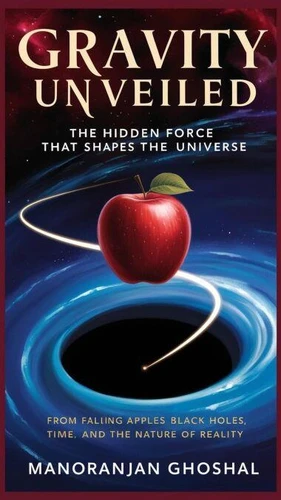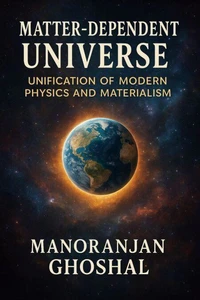Gravity Unveiled: The Hidden Force That Shapes the Universe
Par :Formats :
Disponible dans votre compte client Decitre ou Furet du Nord dès validation de votre commande. Le format ePub est :
- Compatible avec une lecture sur My Vivlio (smartphone, tablette, ordinateur)
- Compatible avec une lecture sur liseuses Vivlio
- Pour les liseuses autres que Vivlio, vous devez utiliser le logiciel Adobe Digital Edition. Non compatible avec la lecture sur les liseuses Kindle, Remarkable et Sony
 , qui est-ce ?
, qui est-ce ?Notre partenaire de plateforme de lecture numérique où vous retrouverez l'ensemble de vos ebooks gratuitement
Pour en savoir plus sur nos ebooks, consultez notre aide en ligne ici
- FormatePub
- ISBN8230789789
- EAN9798230789789
- Date de parution13/04/2025
- Protection num.pas de protection
- Infos supplémentairesepub
- ÉditeurIndependently Published
Résumé
What if gravity is not merely the curvature of spacetime, but the expression of a deeper, more tangible reality?In Gravity Unveiled: The Hidden Force That Shapes the Universe, Manoranjan Ghoshal offers a bold rethinking of one of nature's most fundamental forces. Building upon his Unit Particle Theory (UPT), Ghoshal proposes that gravitation arises from the rotational dynamics and density gradients of a universal field composed of indivisible, fundamental units of matter-called Unit Particles.
This innovative framework suggests that: All fields originate from rotational motion of these fundamental particles around a central point. Gravitational attraction and repulsion are determined by field density and angular momentum, not spacetime distortion. Matter formation, field generation, and force unification can all be explained by the arrangement and behavior of these indivisible Unit Particles.
Gravity, magnetism, and even dark matter can be reinterpreted under a common, elegant principle of rotational balance. Complete with visual diagrams, mathematical suggestions, and deep conceptual discussions, this book is a journey into the architecture of the universe from a truly materialist and mechanistic perspective. It challenges readers to question long-held assumptions and reconsider the nature of reality from the ground up-literally, from the tiniest unit particle.
Whether you're a physicist, philosopher, or curious mind, What Is Gravitation? invites you to look at the cosmos through a new lens-one that spins with purpose, balance, and universal structure.
This innovative framework suggests that: All fields originate from rotational motion of these fundamental particles around a central point. Gravitational attraction and repulsion are determined by field density and angular momentum, not spacetime distortion. Matter formation, field generation, and force unification can all be explained by the arrangement and behavior of these indivisible Unit Particles.
Gravity, magnetism, and even dark matter can be reinterpreted under a common, elegant principle of rotational balance. Complete with visual diagrams, mathematical suggestions, and deep conceptual discussions, this book is a journey into the architecture of the universe from a truly materialist and mechanistic perspective. It challenges readers to question long-held assumptions and reconsider the nature of reality from the ground up-literally, from the tiniest unit particle.
Whether you're a physicist, philosopher, or curious mind, What Is Gravitation? invites you to look at the cosmos through a new lens-one that spins with purpose, balance, and universal structure.
What if gravity is not merely the curvature of spacetime, but the expression of a deeper, more tangible reality?In Gravity Unveiled: The Hidden Force That Shapes the Universe, Manoranjan Ghoshal offers a bold rethinking of one of nature's most fundamental forces. Building upon his Unit Particle Theory (UPT), Ghoshal proposes that gravitation arises from the rotational dynamics and density gradients of a universal field composed of indivisible, fundamental units of matter-called Unit Particles.
This innovative framework suggests that: All fields originate from rotational motion of these fundamental particles around a central point. Gravitational attraction and repulsion are determined by field density and angular momentum, not spacetime distortion. Matter formation, field generation, and force unification can all be explained by the arrangement and behavior of these indivisible Unit Particles.
Gravity, magnetism, and even dark matter can be reinterpreted under a common, elegant principle of rotational balance. Complete with visual diagrams, mathematical suggestions, and deep conceptual discussions, this book is a journey into the architecture of the universe from a truly materialist and mechanistic perspective. It challenges readers to question long-held assumptions and reconsider the nature of reality from the ground up-literally, from the tiniest unit particle.
Whether you're a physicist, philosopher, or curious mind, What Is Gravitation? invites you to look at the cosmos through a new lens-one that spins with purpose, balance, and universal structure.
This innovative framework suggests that: All fields originate from rotational motion of these fundamental particles around a central point. Gravitational attraction and repulsion are determined by field density and angular momentum, not spacetime distortion. Matter formation, field generation, and force unification can all be explained by the arrangement and behavior of these indivisible Unit Particles.
Gravity, magnetism, and even dark matter can be reinterpreted under a common, elegant principle of rotational balance. Complete with visual diagrams, mathematical suggestions, and deep conceptual discussions, this book is a journey into the architecture of the universe from a truly materialist and mechanistic perspective. It challenges readers to question long-held assumptions and reconsider the nature of reality from the ground up-literally, from the tiniest unit particle.
Whether you're a physicist, philosopher, or curious mind, What Is Gravitation? invites you to look at the cosmos through a new lens-one that spins with purpose, balance, and universal structure.






















